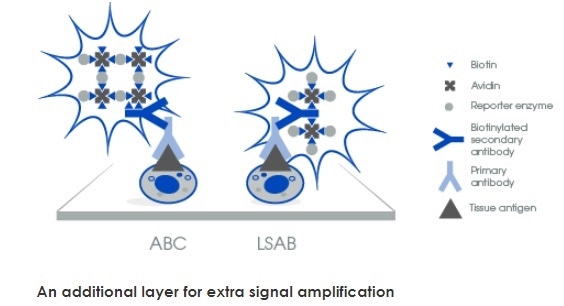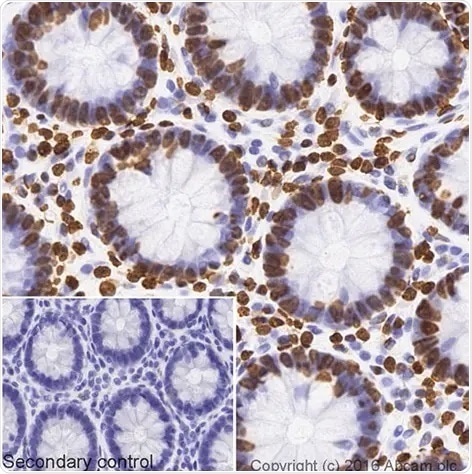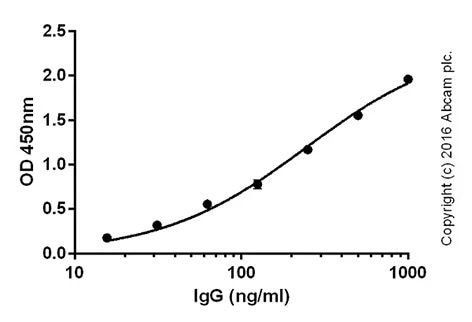Sponsored Content by AbcamJun 6 2019
Using Biotinylated Antibodies to Detect Proteins at Low Concentrations

Biotin can amplify signals by forming complexes of large size with avidin or streptavidin. There are several techniques that use biotinylated secondary antibodies for this purpose, which are dealt with in this article.
Both in ELISA and in immunohistochemical (IHC) methods, it is possible to accomplish signal amplification by using more than one biotin molecules which are conjugated to a secondary antibody. These biotinylated secondary antibodies make it possible to detect proteins whose expression levels are extremely low, without difficulty.
About Biotin
Biotin is a vitamin found in nature which plays a number of important parts in several physiological mechanisms. Biotin binds with strong affinity to avidin or streptavidin, glycoproteins isolated from animal tissues (birds, reptiles and amphibians) and the fungus Streptomyces avidinii, respectively. They are capable of binding up to four biotin molecules each.
This explains why conjugating biotin to antibodies as well as to reporter enzymes or fluorescence carrying molecules results in a powerful amplification of the signal that results from binding of the target antigen. Thus biotinylated antibody-based methods have become key in detecting proteins present at low expression levels.
For more information on biotinylated secondary antibodies, see here. Two methods employ biotinylated antibodies:
Avidin-Biotin Complex (ABC) Method
Here, large complexes formed by avidin and biotin form linkages via reporter enzymes. These are then placed in an incubator along with biotinylated antibodies. The high ratio of enzymes to antibodies leads to signal amplification.
Labeled Streptavidin-biotin (LSAB) Method
In the LSAB method, the biotinylated antibody is incubated with streptavidin-reporter enzyme complexes, causing the signal to be amplified. The complexes formed are smaller than in the ABC technique.

An Additional Layer for Extra Signal Amplification
Both direct and indirect methods are available, but biotinylated antibody-based methods intensify the signal using one more layer. This layer consists of a primary antibody being brought into association with more than one enzyme or fluorophore, which adds greatly to the sensitivity. Some examples of this type of use of biotinylated secondary antibody are shown below:
| |
Direct |
Indirect |
ABC |
LSAB |
| First |
Conjugated primary antibody |
Unlabeled primary antibody |
Unlabeled primary antibody |
Unlabeled primary antibody |
| Second |
|
Conjugated secondary antibody |
Biotinylated secondary antibody |
Biotinylated secondary antibody |
| Third |
|
|
Avidin-biotin complex |
Streptavidin complex |
How to Choose a Methods
Over the course of time, especially in recent years, LSAB methods have overtaken ABC techniques, due in great part to the fact that streptavidin proteins show a lower tendency for non-specific binding. However, LSAB methods have other advantages as shown in the table below.
| |
ABC |
LSAB |
Comments |
| Specificity |
Lower |
Higher |
Avidin may show non-specific binding due to its carbohydrate moieties and its high isoelectric point (pI). In contrast, streptavidin lacks carbohydrate moieties and has a more neutral pI. |
| Sensitivity |
High |
High |
Both methods show greater sensitivity than direct or indirect detection. |
| Tissue penetration |
Lower |
Higher |
The complex size in LSAB methods is smaller facilitating a greater tissue penetration. |
| Sample processing |
More complex |
Simpler |
Both methods require three incubations steps, but ABC methods require an additional incubation of avidin with the reporter enzyme. |
Some Issues with the Use of Biotinylated Antibodies
Biotinylated antibodies are widely used at present, but they have some issues. One is that tissues which contain endogenous biotin will return a falsely high background signal. To prevent this, it is vital to block endogenous biotin in all tissues where biotin is expressed at high levels, as in the kidneys and the liver. In frozen tissue sections, it is also advisable to use detection methods not based upon biotin, because they contain high levels of endogenous biotin.
Choosing the Right Product for Your Research
Both biotinylated and biotin-binding proteins are available for all kinds of research from Abcam, whose range offers:
The usefulness of these biotinylated antibody methods in both ELISA and IHC are displayed in the images below.

HC image of Anti-Histone H4 [EPR16599] – ChIP Grade RabMAb antibody (ab177840) staining in a section of FFPE human colon tissue. Goat Anti-Rabbit IgG H&L (Biotin) (ab207995) was used as the secondary antibody. Endogenous biotin was blocked using Endogenous Avidin/Biotin Blocking Kit (ab64212). Detection was via an HRP conjugated ABC system and DAB was used as the chromogen. The section was then counterstained with haematoxylin. The inset negative control image is taken from an identical assay without primary antibody. For further details, visit the datasheet here.

ELISA testing of Goat Anti-Rabbit IgG H&L (Biotin) (ab207995) using wells coated with serially diluted mouse IgG. Antibody binding was detected with Streptavidin-HRP (ab7403). Signal was developed by TMB substrate. For further details, visit the datasheet here.
 About Abcam
About Abcam
Abcam is a global life sciences company providing highly validated antibodies and other binders and assays to the research and clinical communities to help advance the understanding of biology and causes of disease.
Abcam’s mission is to serve life scientists to help them achieve their mission faster by listening to their needs, continuously innovating and improving and by giving them the tools, data and experience they want. Abcam’s ambition is to become the most influential life science company for researchers worldwide.
Sponsored Content Policy: News-Medical.net publishes articles and related content that may be derived from sources where we have existing commercial relationships, provided such content adds value to the core editorial ethos of News-Medical.Net which is to educate and inform site visitors interested in medical research, science, medical devices and treatments.